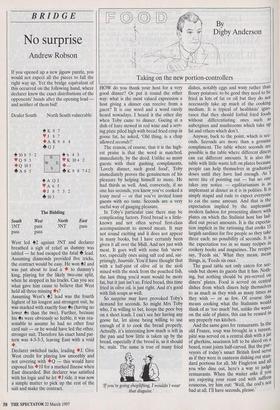BRIDGE
No surprise
Andrew Robson
If you opened up a new jigsaw puzzle, you would not expect all the pieces to fall the right way up. Yet the bridge equivalent of this occurred on the following hand, where declarer knew the exact distributions of the opponents' hands after the opening lead and neither of them bid!
Dealer South North South vulnerable 4 K 9 7 J 8 7 • A K9 6 4 +QJ
4 10 8 5 V Q 9 3
♦ Q 10 5 A 6 5 2
46 4 3 ♦ K 104 • — • K 9 8 2
742
w N E 4A QJ • A 6 5
• J 8 7 3 2 + 10 3
The Bidding
South West North East 1NT pass 3NT pass pass pass West led 42 against 3NT and declarer breathed a sigh of relief as dummy was tabled — he had escaped the fatal + lead. Assuming diamonds provided five tricks, the contract would be easy. He won 4J and was just about to lead a ♦ to dummy's king, playing for the likely two-one split, when he stopped in his tracks. Can you see what gave him cause to believe that West held all three missing ♦s?
Assuming West's 42 lead was the fourth highest of his longest and strongest suit, he was marked with exactly four 4s (having no lower 4s than the two). Further, because his 4s were obviously so feeble, it was rea- sonable to assume he had no other four card suit — or he would have led the other, stronger suit. Therefore his exact hand pat- tern was 4-3-3-3, leaving East with a void ♦ .
Declarer switched tacks, leading •J. Give West credit for playing low smoothly and not covering with ♦Q — this would have exposed his • 10 for a marked finesse when East discarded. But declarer was satisfied with his logic and he let ♦J ride. it was now a simple matter to pick up the rest of the suit and make the contract.


































































 Previous page
Previous page